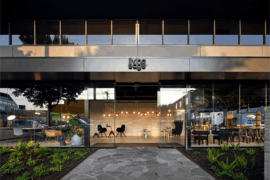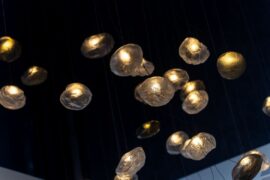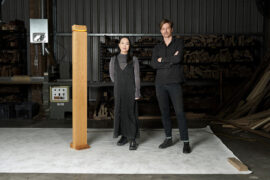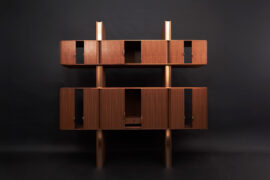Bocci’s Creative Director, Omer Arbel, talks to IIiyas Ong about materials, his unique methodology, and shares why his bad eyesight allows for good design.

October 8th, 2013
Omer Arbel has terrible sight in one eye and good sight in the other, yet hates wearing spectacles. Despite the advice of doctors, the 37-year-old Vancouver-based designer and architect remains unconvinced. But this is less about vanity than it is about his work as the Creative Director of Bocci, a firm renowned for its extroverted lighting designs.
“I’m very sensitive to light,” shares Arbel while in Singapore recently for the INSIDE festival, and to give a talk at Space Furniture. “But I notice that all my sensitivity to light disappears as soon as I wear eyeglasses. There’s an amazing balance of blurring and colours and crispness that I really love—and I’d wreck it if I wear glasses.”
No. 14
Arbel’s work at Bocci is representative of that “amazing balance”. His lighting units straddle the organic and the designed, and are almost always clustered, which the Canadian attributes to the way his semi-poor eyesight appreciates light. But it would be inaccurate to chalk the success of Bocci’s products solely up to Arbel’s lack of eyewear. That should also be pinned on the designer’s distinct methodology by which he wroughts startling—and sometimes improbable—forms from raw material.
No. 19
According to Arbel, who admits to being “obsessed with form” all his life, his process is opposite to that of many designers today. Instead of developing a language of forms with which products can be designed like how sentences are constructed, Arbel prefers taking a step back in the authorship process and let “the material teach [him]”.
No. 28
“We put our egos aside and let the material or process that we’re investigating teach us about form,” he explains. “We start with experimentation; it’s almost like a lab. And with enough experimentation, there’s a ‘magic’ thing that happens. Then our role is almost as editors: to focus on the ‘magic’ thing and try to curate the instances of its occurrence. You have to imagine light, electricity, and so on, but those layers of technical proficiency are applied on top of the material discovery.”
No. 38
When starting a new piece, Arbel begins with technology; not necessarily cutting-edge technology, but innovative uses for old technology. The craftsmanship and technology are points of departure for him rather than a means to an end. So Arbel doesn’t say, “I want to make this; what are the technologies I can use?” Rather, he manipulates existing machines or processes to find out what strange and new forms can be created from the tweaking.
For example, in 38 (all his designs have numbers for names), the designer reversed the centuries-old craft of glass-blowing by asking, “What happens if you do the opposite and pull air out?”
No. 57
It may sound like a child’s naïve question, but Arbel insists that if you take that question seriously, you’ll start learning more about glass: how it responds to temperature, gravity, and air. He persuaded a truculent glass-blower to pull the air out of a cold glass sphere, around which were numerous heated spots of white glass, effectively creating a vacuum in the sphere.
Arbel’s house
The result? White ‘globs’ forming and sticking to the inside of the clear sphere, almost as though it had beautifully imploded. Some of these ‘globs’ house lightbulbs; others can be used as vases. It is whimsical, uninhibited, and deceptively simple. It also looks like a magic trick.
Arbel’s house
Bocci is carried in Singapore at Space Furniture.
INDESIGN is on instagram
Follow @indesignlive
A searchable and comprehensive guide for specifying leading products and their suppliers
Keep up to date with the latest and greatest from our industry BFF's!

For Aidan Mawhinney, the secret ingredient to Living Edge’s success “comes down to people, product and place.” As the brand celebrates a significant 25-year milestone, it’s that commitment to authentic, sustainable design – and the people behind it all – that continues to anchor its legacy.
The new range features slabs with warm, earthy palettes that lend a sense of organic luxury to every space.

Lighting becomes storytelling in the hands of Bocci and Moooi – brands championed by Space Furniture.

Space Furniture has opened the world’s first standalone B&B Italia Outdoor showroom, a landmark space celebrating an enduring partnership of over 30 years with B&B Italia.
The internet never sleeps! Here's the stuff you might have missed

AHEC’s KEEP exhibition at Cult Sydney sees six Australian architects craft lasting furniture pieces, on view until 4th October.

Adam Markowitz Design, in collaboration with Simeon Dux, has been awarded The Object at the INDE.Awards 2025. Their winning project, A Cabinet of Curiosities, is a masterwork of craftsmanship and adaptability; a poetic response to shifting domestic and professional life in the post-COVID era.